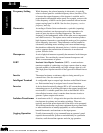
L100 Inverter
Troubleshooting
and Maintenance
6–11
General Inverter Electrical Measurements
The following table specifies how to measure key system electrical parameters. The
diagrams on the next page show inverter-motor systems and the location of measurement
points for these parameters.
Note 1:
Use a meter indicating a fundamental wave effective value for voltage, and meters indicating
total effective values for current and power.
Note 2:
The inverter output has a distorted waveform, and low frequencies may cause erroneous
readings. However, the measuring instruments and methods listed above provide comparably
accurate results.
Note 3:
A general-purpose digital volt meter (DVM) is not usually suitable to measure a distorted
waveform (not pure sinusoid).
Parameter
Circuit location
of measurement
Measuring
instrument
Notes Reference Value
Supply voltage
E
1
E
R
– across L1 and L2
E
S
– across L2 and L3
E
T
– across L3 and L1
Moving-coil
type voltmeter or
rectifier type
voltmeter
Fundamental
wave effective
value
Commercial
supply voltage
(200V class) 200-
240V, 50/60 Hz
400V class 380-
460V, 50/60 Hz
Supply current
I
1
I
r
– L1, I
s
– L2, I
t
– L3 Total effective
value
—
Supply power
W
1
W
11
– across L1 and L2
W
12
– across L2 and L3
Total effective
value
—
Supply power
factor Pf
1
—
Output voltage
E
0
E
U
– across U and V
E
V
– across V and W
E
W
– across W and U
Rectifier type
voltmeter
Total effective
value
—
Output current
I
o
I
U
– U
I
V
– V
I
W
– W
Moving-coil
ammeter
Total effective
value
—
Output power
W
o
W
01
– across U and V
W
02
– across V and W
Electronic type
wattmeter
Total effective
value
—
Output power
factor Pf
o
Calculate the output power factor from the output voltage E,
output current I, and output power W.
—
Pf
1
W
1
3E
1
× I
1
×
------------------------------
100%×=
Pf
0
W
0
3E
0
× I
0
×
------------------------------
100%×=
Technologies Inc.
Toll Free: voice: 1-877-539-2542 fax: 1-800-539-2542 www.mgitech.com


















